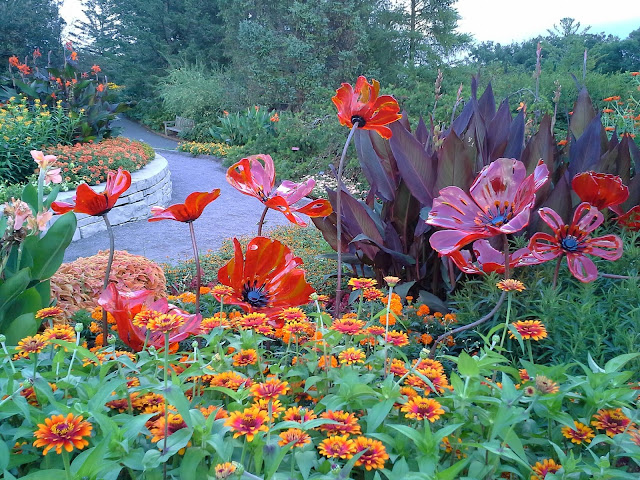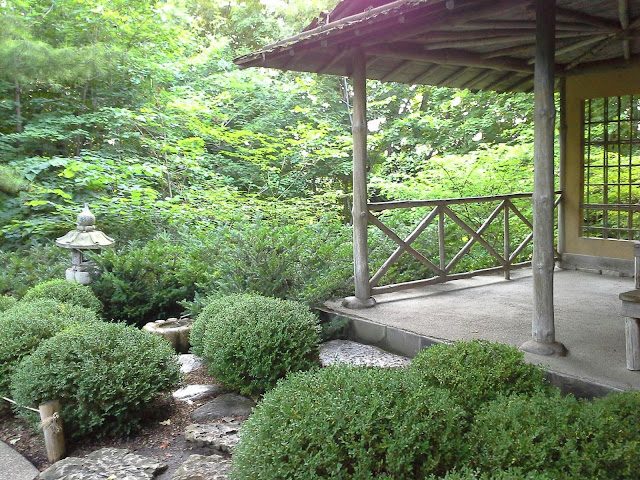Yesterday an article showed up on my facebook feed that caught my attention and I just have to share it. They have discovered microbes in soil that are antidepressant. That's right, playing in the dirt is actually good for your mental health.
Here is the link to the article: How Dirt Makes You Happy.
So get out there and play in the dirt!
Yes, I Talk to Plants
discoveries and musings of a Minnesota gardener
Thursday, March 5, 2015
Monday, August 25, 2014
Arboretum Evening
Apparently this year's theme was to arrange everything by color.
The current featured artwork displayed throughout the Arboretum was a series of glass flowers. I love how the artwork was placed to complement the real flowers surrounding it. The light sparkling through the glass added a neat element to the gardens, too.
Somehow, I like the monochromatic nature of this planting.
We also visited the Japanese garden. This is the Tea House with a pagoda and water bowl on the left side.
This is an awesome, old Redbud (Cercis canadensis). The two trunks are going in every direction like over-sized Bonsai; I wonder if they were trained to do that?
No Japanese garden would be complete without a koi pond. Do you see the glass koi?
I really enjoyed my visit to the Arboretum. It was a nice change from my everyday routine. I need to get back here in the fall. There is a huge witch hazel (Hamamelis virginiana) that I want to see in bloom.
Thursday, August 14, 2014
a Turtle by any other name is still as neat
I was visiting my in-laws today and happened to look at a wildlife calendar they have on their fridge. Oh neat, a green sea turtle. I like sea turtles. The caption said the scientific name for the turtle was Chelonia mydas.
Wait, Chelonia? The scientific name for turtle is Chelonia? Gee, that sure is an awful lot like....
...Chelone!
Now it makes perfect sense why the scientific name for Turtlehead is Chelone! I love it when these kinds of connections are made!

| hi |
Wait, Chelonia? The scientific name for turtle is Chelonia? Gee, that sure is an awful lot like....
...Chelone!
| Chelone lyonii |
Now it makes perfect sense why the scientific name for Turtlehead is Chelone! I love it when these kinds of connections are made!
Incidentally, I have always mixed up the scientific names for Turtlehead (Chelone) and Spider Flower (Chleome). I don't know why. Probably the same reason why I always read "uniformed" as "uninformed," and for years thought that Morden Sunrise Rose was Modern Sunrise Rose.
But now I'll always remember the right name because I learned the name for turtle!
Saturday, June 14, 2014
Como Zoo Conservatory
Meet my new partner in crime, William! (born September 2013)
The two of us had the opportunity to visit the Marjorie McNeely Conservatory in March. It was great to be around all the greenery after a long, cold Minnesota winter, and introduce William to the wonder of plants. He wasn't too interested in the plants, but he got really excited about the big kitties (lions, tigers, and cougars, oh my!) that we saw later.
Below are pictures from the Fern Room. I've tried to get the names of a few of them, but it's been a while since I took the pictures so I can't remember which name matches up with which fern. If you know I've given one the wrong name, please let me know! (If you want to see pictures from the last time I was at the Fern Room, click here.)
 |
| wall of Staghorn Fern Platycerium ziesenhenne |
 |
| Dwarf Tree Fern Blechnum brasiliense |
 |
| Woolly Tree Fern Dicksonia fibrosa |
 |
| Japanese Birdnest Fern Asplenium antiquum |
No trip to the Conservatory would be complete without visiting the Sunken Garden. Below are pictures of their Winter Flower Show. (For pictures of the Winter Flower Show from my last trip here, click here.
Saturday, January 19, 2013
Fall Revisited
Remember how I said I'd have a new post soon? Over a month ago? Life sure has this nasty habit of getting in the way, doesn't it?
Now that that's out of the way, let's go back in time and enjoy some autumn containers. These are on either side of our porch steps.


I used a mixture of live, natural, and artificial materials. The things that are alive are the little mums (Chrysanthemum sp.) and the ornamental cabbage (Brassica oleracea). The naturals are the dried Annabelle hydrangea (Hydrangea arborescans 'Annabelle') blooms, dried ostrich fern spore-bearing fronds (Matteuccia struthiopteris), green-dyed twine balls, and dried lotus pods affixed to a bendy wire. The artificial materials are the glittery feather ball and fern fronds, crabapple branches, and green orbs.
The ornamental cabbage was amazing. The purple grew brighter as the temperatures got cooler, and even withstood a few frosts. I know not everyone likes cabbage or kale, but when precious few plants (read: no plants) are blooming in October and November, I think it is a definite must for a Minnesota autumn display.
While sorting through the pictures to use in this post, I discovered a spring project: paint those containers! They are a Styrofoam/resin composite so they are nice and light (when not loaded with plants and wet soil) and have been outside for about four years. But why everything except the rim faded, I have no idea.
Subscribe to:
Comments (Atom)



























